Bhushan B. Nanotribology and Nanomechanics: An Introduction
Подождите немного. Документ загружается.


14 Mechanical Properties of Nanostructures 747
where k is the stiffness of the tip/cantilever. In this manner, a load displacement
curve for each nanobeam can be obtained.
The photodetector sensitivity of the cantilever needs to be calibrated to obtain
D
tip
in nm. For this calibration, the tip is pushed against a smooth diamond sample
by moving the Z-piezo over a known distance. For the hard diamond material, the
actual deflection of the tip can be assumed to be the same as the Z-piezo travel
(D
piezo
), and the photodetector sensitivity (S) for the cantilever setup is determined
as
S = D
piezo
/dV
AFM
nm/V . (14.4)
In the measurements, D
tip
is given as dV
AFM
×S.
Since a sharp tip would result in an undesirable large local indentation, Sun-
dararajan and Bhushan [62] used a diamond tip which was a worn (blunt) diamond
tip. Indentation experiments using this tip on a silicon substrate yielded a residual
depth of less than 8nm at a maximum load of 120µN, which is negligible com-
pared to displacements of the beams (several hundred nm). Hence we can assume
that negligible local indentation or damage is created during the bending process
of the beams and that the displacement calculated from (14.2) is from the beam
structure.
Elastic Modulus and Bending Strength
Elasticmodulus and bendingstrength(fracture stress) of the beams can be estimated
by equations based on the assumption that the beams follow linear elastic theory of
an isotropic material. This is probably valid since the beams have high length-to-
width /w and length-to-thickness /t ratios and also since the length direction is
along the principal stress direction during the test. For a fixed elastic beam loaded
at the center of the span, the elastic modulus is expressed as
E =
3
192I
m , (14.5)
where is the beam length, I is the area moment of inertia for the beam cross-
section and m is the slope of the load-displacement curve during bending [85]. The
area moment of inertia for a beam with trapezoidal cross section, is calculated from
the following equation
I =
w
2
1
4w
1
w
2
+ w
2
2
36
(
w
1
+ w
2
)
t
3
, (14.6)
where w
1
and w
2
are the upper and lower widths, respectively, and t is the thickness
of the beam. According to linear elastic theory, for a centrally loaded beam, the
moment diagramis shown in Fig. 14.2. The maximummoments are generated at the
ends (negative moment) and under the loading point (positive moment) as shown
in Fig. 14.2. The bending stresses generated in the beam are proportional to the
moments and are compressive or tensile about the neutral axis (line of zero stress).
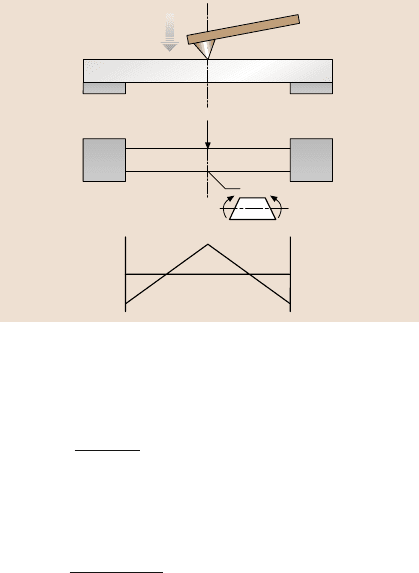
748 Bharat Bhushan
Beam
Neutral
axis
Positive
M
Bending
moment
M
MM
Fig. 14.2. A schematic of the
bending moments generated
in the beam during a quasi-
static bending experiment,
with the load at the center
of the span. The maximum
moments occur under the
load and at the fixed ends.
Due to the trapezoidal cross
section, the maximum tensile
bending stresses occur at the
top surfaces at the fixed ends
The maximum tensile stress (σ
b
, which is the bending strength or fracture stress) is
produced on the top surface at both the ends and is given by [85]
σ
b
=
F
max
e
1
8I
, (14.7)
where F
max
is the applied load at failure and e
1
is the distance of the top surface
from the neutral plane of the beam cross-section and is given by [85]
e
1
=
t
(
w
1
+ 2w
2
)
3
(
w
1
+ w
2
)
. (14.8)
Although the moment value at the center of the beam is the same as at the ends, the
tensile stresses at the center (generated on the bottom surface) are less than those
generated at the ends (per (14.7)) because the distance from the neutral axis to the
bottom surface is less than e
1
. This is because of the trapezoidal cross section of the
beam, which results in the neutral axis being closer to the bottom surface than the
top (Fig. 14.2).
In the preceding analysis, the beams were assumed to havefixed ends. However,
in the nanobeams used by Sundararajan and Bhushan [62], the underside of the
beams was pinned over some distance on either side of the span. Hence a finite
element model of the beams was created to see if the difference in the boundary
conditions affected the stresses and displacements of the beams. It was found that
the difference in the stresses was less than 1%. This indicates that the boundary
conditions near the ends of the actual beams are not that different from that of fixed
ends. Therefore the bending strength values can be calculated from (14.7).
Fracture Toughness
Fracture toughness is another important parameter for brittle materials such as sili-
con. In the case of the nanobeamarrays, these are not best suited for fracture tough-
ness measurements because they do not possess regions of uniform stress during
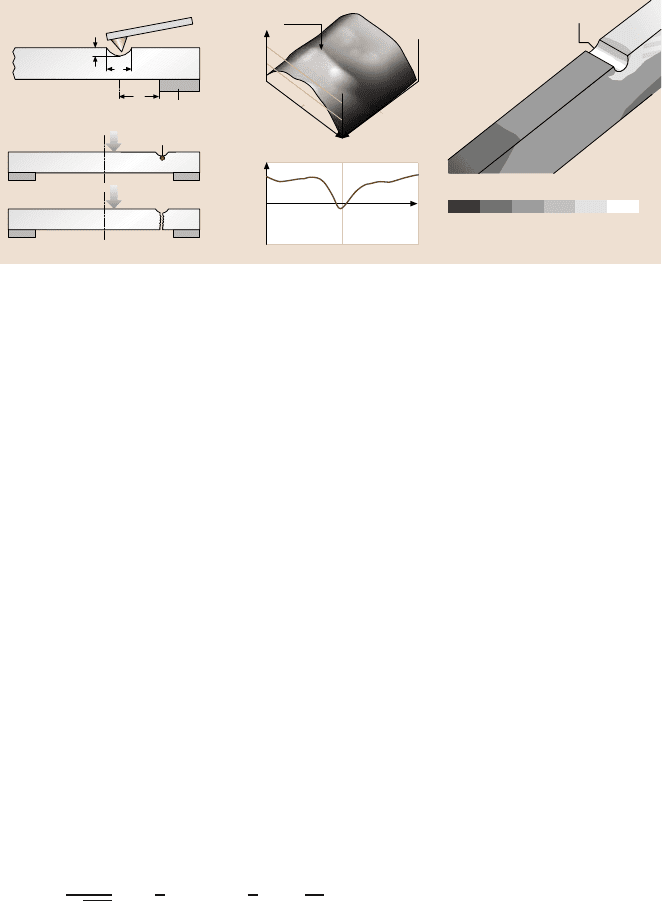
14 Mechanical Properties of Nanostructures 749
1500
750
0
250
500
nm nm
250
0
Scratch
50
0
–50
nm
250 5000
nm
b)a)
Beam
d
c
Substrate
Diamond tip
a
Load Stress
concentration
Fracture
load
c)
Maximum tensile
bending stress
– 25 – 16 – 11 – 4 3 10 17
GPa
Fig. 14.3. (a) Schematic of technique to generate a defect (crack) of known dimensions in
order to estimate fracture toughness. A diamond tip is used to generate a scratch across the
width of the beam. When the beam is loaded as shown, a stress concentration is formed at
the bottom of the scratch. The fracture load is then used to evaluate the stresses using FEM.
(b) AFM 3-D image and 2-D profile of a typical scratch. (c) Finite element model results
verifying that the maximum bending stress occurs at the bottom of the scratch [62]
bending. Sundararajan and Bhushan [62] developed a methodology and its steps
are outlined schematically in Fig. 14.3a. First, a crack of known geometry is intro-
duced in the region of maximum tensile bending stress, i.e. on the top surface near
the ends of the beam. This is achieved by generating a scratch at high normal load
across the width (w
1
) of the beam using a sharp diamond tip (radius < 100nm).
A typical scratch thus generated is shown in Fig. 14.3b. By bending the beam as
shown, a stress concentration will be formed under the scratch. This will lead to
failure of the beam under the scratch once a critical load (fracture load) is attained.
The fracture load and relevant dimensions of the scratch are input into the FEM
model, which is used to generate the fracture stress plots. Figure 14.3c shows an
FEM simulation of one such experiment, which reveals that the maximum stress
does occur under the scratch.
If we assume that the scratch tip acts as a crack tip, a bending stress will tend
to open the crack in Mode I. In this case, the stress field around the crack tip can
be described by the stress intensity parameter K
I
(for Mode I) for linear elastic
materials [86]. In particular the stresses corresponding to the bending stresses are
described by
σ =
K
I
√
2πr
cos
θ
2
1+ sin
θ
2
sin
3θ
2
(14.9)
for every point p(r,θ) around the crack tip as shown in Fig. 14.4.If we substitute the
fracture stress (σ
f
) into the left hand side of (14.9), then the K
I
value can be sub-
stituted by its critical value, which is the fracture toughness K
IC
.Now,thefracture
stress can be determined for the point (r = 0,θ = 0), i.e. right under the crack tip as
explained above.However, we cannot substitute r = 0 in (14.9). The alternativeis to
substitute a value for r, which is as close to zero as possible. For silicon, a reason-
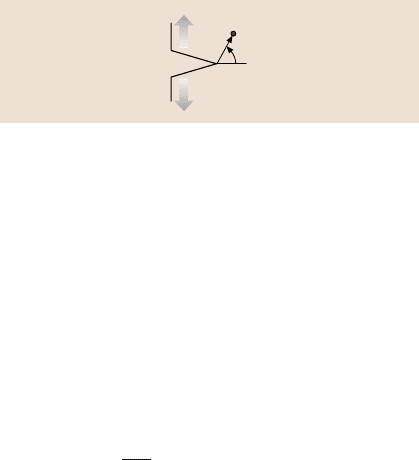
750 Bharat Bhushan
Bending
stress
Crack
r
θ
p(r, θ)
Fig. 14.4. Schematic of crack tip and coordinate systems used in (14.9) to describe a stress
field around the crack tip in terms of the stress intensity parameter, K
I
[62]
able number is the distance between neighboringatoms in the (111) plane, the plane
along which silicon exhibits the lowest fracture energy. This value was calculated
from silicon unit cell dimensions of 0.5431nm [87] to be 0.4 nm (half of the face
diagonal). This assumes that Si displays no plastic zone around the crack tip, which
is reasonable since in tension, silicon is not known to display much plastic defor-
mation at room temperature. Sundararajan and Bhushan [62] used values r = 0.4
to 1.6 nm (i.e. distances up to 4 times the distance between the nearest neighbor-
ing atoms) to estimate the fracture toughness for both Si and SiO
2
according to the
following equation
K
IC
= σ
f
√
2πrr= 0.4to1.6nm. (14.10)
Fatigue Strength
In addition to the properties mentioned so far that can be evaluated from quasi-static
bending tests, the fatigue propertiesof nanostructuresare also of interest. This is es-
pecially true for MEMS/NEMS involving vibrating structures such as oscillators
and comb drives [88] and hinges in digital micromirror devices [89]. To study the
fatigue propertiesof the nanobeams,Sundararajanand Bhushan[62] appliedmono-
tonic cyclic stresses using an AFM, Fig. 14.5a. Similar to the bending test, the dia-
mond tip is first positioned at the center of the beam span. In order to ensure that the
tip is always in contact with the beam (as opposed to impacting it), the piezo is first
extended by a distance D
1
, which ensures a minimum stress on the beam. After this
extension, a cyclic displacement of amplitude D
2
is applied continuously until fail-
ure of the beam occurs. This results in the application of a cyclic load to the beam.
The maximum frequency of the cyclic load that could be attained using the AFM by
Sundararajanand Bhushan [62] was 4.2 Hz. The vertical deflection signal of the tip
is monitored throughout the experiment. The signal follows the pattern of the piezo
input up to failure, which is indicated by a sudden drop in the signal. During initial
runs, piezo drift was observed that caused the piezo to gradually move away from
the beam (i.e. to retract), resulting in a continuous decrease in the applied normal
load. In order to compensate for this, the piezo is given a finite extension of 75nm
every 300seconds as shown in Fig. 14.5a. This results in keeping the applied loads
fairly constant. The normal load variation (calculated from the vertical deflection
signal) from a fatigue test is shown in Fig. 14.5b. The cyclic stress amplitudes (cor-

14 Mechanical Properties of Nanostructures 751
a)
b)
Beam
Piezo
Cyclic load
Frequency = 4.2 Hz
D
2
D
1
Compensate for piezo drift
75 nm every 300 s
Time
Piezo extension
125
100
75
50
25
0
Normal load (μN)
0 200 400 600
Time (s)
Piezo drift
compensation
Failure
Fig. 14.5. (a) Schematic
showing the details of the
technique to study fatigue
behavior of the nanobeams.
The diamond tip is located
at the middle of the span
and a cyclic load at 4.2Hz
is applied to the beam by
forcing the piezo to move in
the pattern shown. An ex-
tension is made every 300 s
to compensate for the piezo
drift to ensure that the load on
the beam is kept fairly con-
stant. (b) Data from a fatigue
experiment on a nanobeam
until failure. The normal load
is computed from the raw
vertical deflection signal.
The compensations for piezo
drift keep the load fairly con-
stant [62]
responding to D
2
) and fatigue lives are recorded for every sample tested. Values for
D
1
are set such that minimum stress levels are about 20% of the bending strengths.
14.2.3 Bending Tests of Micro/Nanostructures Using a Nanoindenter
Quasi-static bending tests of micro/nanostructuresare also carried out using a nano-
indenter(Fig. 14.6) [63–65].The advantageof nanoindenteris that loads up to about
400mN, higher than that in AFM (up to about 100µN), can be used for structures
requiringhigh loadsfor experiments.To avoid theindenter tip pushinginto thespec-
imen, a blunt tip is used in the bending and fatigue tests. For ceramic and metallic
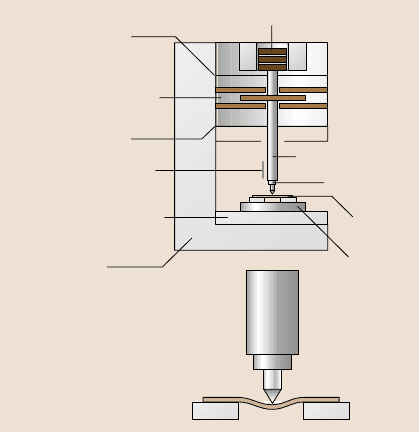
752 Bharat Bhushan
Capacitive
displacement gauge
Heating
stage
Load application coil/magnet
Indenter
support springs
Indenter
support springs
Lateral force probe
Lateral motion stage
Load frame
Indenter column
Indenter tip
Beam
sample
Fig. 14.6. Schematic of mi-
cro/nanoscale bending test
using a nanoindenter
beam samples, Li et al. [64] used a diamond conical indenter with a radius of 1µm
and an included angle of 60
◦
. For polymer beam samples, Wei et al. [65] reported
that the diamond tip penetrated the polymer beams easily and caused considerable
plastic deformation during the bending test, which led to significant errors in the
measurements. To avoid this issue, the diamond tip was dip-coated with PMMA
(about 1–2 µm thick) by dipping the tip in the 2% PMMA (wt/wt)solution forabout
5 seconds. Load position used was at the center of the span for the bridge beams and
at 10µmoff from the free end of cantilever beams. An optical microscope with
a magnification of 1500 × or an in-situ AFM is used to locate the loading position.
Then the specimen is moved under the indenter location with a resolution of about
200 nm in longitudinal direction and less than 100nm in lateral direction.
Using the analysis presented earlier, elastic modulus and bending strength of
the beams can be obtained from the load displacement curves [64,65]. For fatigue
tests, an oscillating load is applied and contact stiffness is measured during the tests.
A significant drop in the contact stiffness during the test is a measure of number of
cycles to failure [63].
14.3 Experimental Results and Discussion
14.3.1 Indentation and Scratch Tests of Various Ceramic and Metals
Using a Micro/Nanoindenter
Studies have been conducted on five different materials: undoped single-crystal
Si(100), undoped polysilicon film, SiO
2
film, SiC film, electroless deposited Ni–

14 Mechanical Properties of Nanostructures 753
11.5wt% P amorphousfilm, and electroplatedAu film [64,75,76].A 3µm thickpo-
lysilicon film was deposited by a low pressure chemical vapor deposition
(LPCVD) process on an Si(100) substrate. The 1µmthickSiO
2
film was de-
posited by a plasma enhanced chemical vapor deposition (PECVD) process on an
Si(111) substrate. A 3µm thick 3C-SiC film was epitaxially grown using an atmo-
spheric pressure chemical vapor deposition (APCVD) process on Si(100) substrate.
A12µmthickNi
−
P film was electroless plated on a 0.8mmthickAl−4.5wt%Mg
alloy substrate. A 3µm thick Au film was electroplated on an Si(100) substrate.
Hardness and Elastic Modulus
Hardness and elastic modulus measurements are made using a nanoindenter [64].
The hardness and elastic modulus values of various materials at a peak indentation
depth of 50nm are summarized in Fig. 14.7 and Table 14.1. The SiC film exhibits
the highest hardness of about 25GPa an elastic modulus of about 395GPa among
the samples examined, followed by the undoped Si(100), undoped polysilicon film,
SiO
2
film, Ni
−
P film, and Au film. The hardness and elastic modulus data of the
undoped Si(100) and undoped polysilicon film are comparable. For the metal al-
loy films, the Ni
−
P film exhibits higher hardness and elastic modulus than the Au
film.
Fracture Toughness
The optical images of Vickers indentations made using a microindenter,at a normal
load of 0.5N held for 15 s on the undoped Si(100), undoped polysilicon film, and
SiC film are shown in Fig. 14.8 [76]. The SiC film exhibits the smallest indenta-
tion mark, followed by the undoped polysilicon film and undoped Si(100). These
Vickers indentation depths are smaller than one-third of the film thickness. Thus,
the influence of substrate on the fracture toughness of the films can be ignored. In
addition to the indentation marks, radial cracks are observed, emanating from the
indentation corners. The SiC film shows the longest radial crack length, followed
by the undoped Si(100) and undoped polysilicon film. The radial cracks for the un-
doped Si(100) are straight whereas those for the SiC, undoped polysilicon film are
Table 14.1. Hardness, elastic modulus, fracture toughness and critical load results of the bulk
single-crystal Si(100) and thin films of undoped polysilicon, SiO
2
,SiC,Ni
−
PandAu
Samples Hardness Elastic modulus Fracture toughness Critical load
(GPa) (GPa) (MPam
1/2
)(mN)
Undoped Si(100) 12 165 0.75 11
Undoped polysilicon film 12 167 1.11 11
SiO
2
film 9.5 144 0.58 (Bulk) 9.5
SiC film 24.5 395 0.78 14
Ni
−
Pfilm 6.5 130 0.4 (Plowing)
Au film 4 72 0.4 (Plowing)
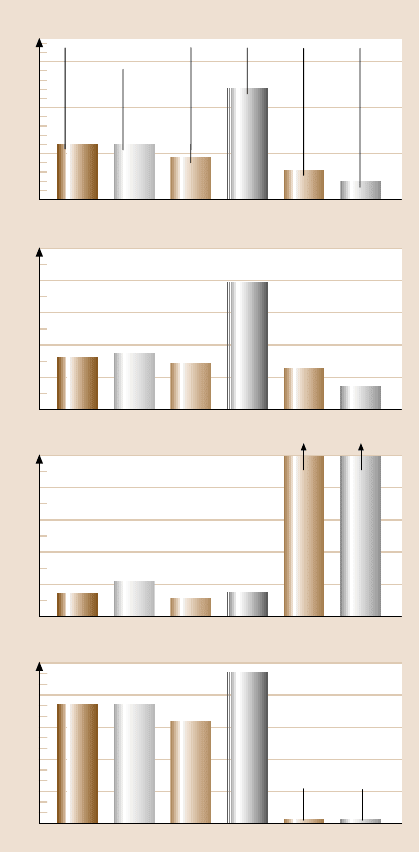
754 Bharat Bhushan
not straight but go in a zigzag manner. The fracture toughness (K
IC
) is calculated
using (14.1).
The fracture toughness values of all samples are summarized in Fig. 14.7 and
Table 14.1. The SiO
2
film used in this study is about 1 µm thick, which is not thick
enough for fracture toughness measurement. The fracture toughness value of bulk
silica are listed instead for a reference. The Ni
−
P and Au films exhibit very high
fracture toughness values that cannot be measured by indentation methods. For
other samples, the undoped polysilicon film has the highest value, followed by the
15
12
9
6
3
0
Critical load (mN)
Plowing
5
4
3
2
1
0
K
IC
(MPa m
1/2
)
Bulk
500
400
300
200
100
0
Elastic modulus (GPa)
30
20
10
0
Hardness (GPa)
Undoped
Si (100)
Undoped
poly-
silicon
film
SiO
2
film
SiC
film
Ni-P
film
Au-
film
Fig. 14.7. Bar chart summa-
rizing the hardness, elastic
modulus, fracture toughness,
and critical load (from scratch
tests) results of the bulk un-
doped single-crystal Si(100)
and thin films of undoped
polysilicon, SiO
2
,SiC,Ni
−
P,
andAu[64]
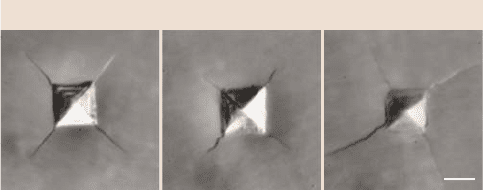
14 Mechanical Properties of Nanostructures 755
Undoped Si (100) Undoped polysilicon film
5 μm
SiC film
Fig. 14.8. Optical images of Vickers indentations made at a normal load of 0.5Nheldfor15s
on the undoped Si(100), undoped polysilicon film, and SiC film [76]
undoped Si(100), SiC film, and SiO
2
film. For the undoped polysilicon film, the
grain boundaries can stop the radial cracks and change the propagation directions
of the radial cracks, making the propagation of these cracks more difficult. Values
of fracture toughness for the undoped Si(100) and SiC film are comparable. Since
the undoped Si(100) and SiC film are single crystal, no grain boundaries are present
to stop the radial cracks and change the propagation directions of the radial cracks.
This is why the SiC film shows a lower fracture toughness value than the bulk poly-
crystal SiC materials of 3.6MPam
1/2
[90].
Scratch Resistance
Scratch resistance of various materials have been studied using a nanoindenter by
Li et al. [64]. Figure 14.9 compares the coefficient of friction and scratch depth pro-
files as a function of increasing normal load and optical images of three regions
over scratches: at the beginning of the scratch (indicated by A on the friction pro-
file), at the point of initiation of damage at which the coefficientof friction increases
to a high value or increase abruptly (indicated by B on the friction profile), and to-
wards the end of the scratch (indicated by C on the friction profile) for all samples.
Note that the ramp loads for the Ni
−
P and Au range are from 0.2 to 5 mN whereas
the ramp loads for other samples are from 0.2 to 20mN. All samples exhibit a con-
tinuous increase in the coefficient of friction with increasing normal load from the
beginning of the scratch. The continuous increase in the coefficient of friction dur-
ing scratching is attributed to the increasing plowing of the sample by the tip with
increasing normal load, as shown in the SEM images in Fig. 14.9. The abrupt in-
crease in the coefficient of friction is associated with catastrophic failure as well
as significant plowing of the tip into the sample. Before the critical load, the coeffi-
cient of friction ofthe undoped polysilicon,SiC and SiO
2
films increased at a slower
rate, and was smoother than that of the other samples. The undoped Si(100)exhibits
some bursts in the friction profiles before the critical load. At the critical load, the
SiC and undoped polysilicon films exhibit a small increase in the coefficient of fric-
tion whereas the undoped Si(100) and undoped polysilicon film exhibit a sudden
increase in the coefficient of friction. The Ni
−
P and Au films show a continuous
increase in the coefficient of friction, indicating the behavior of a ductile metal. The
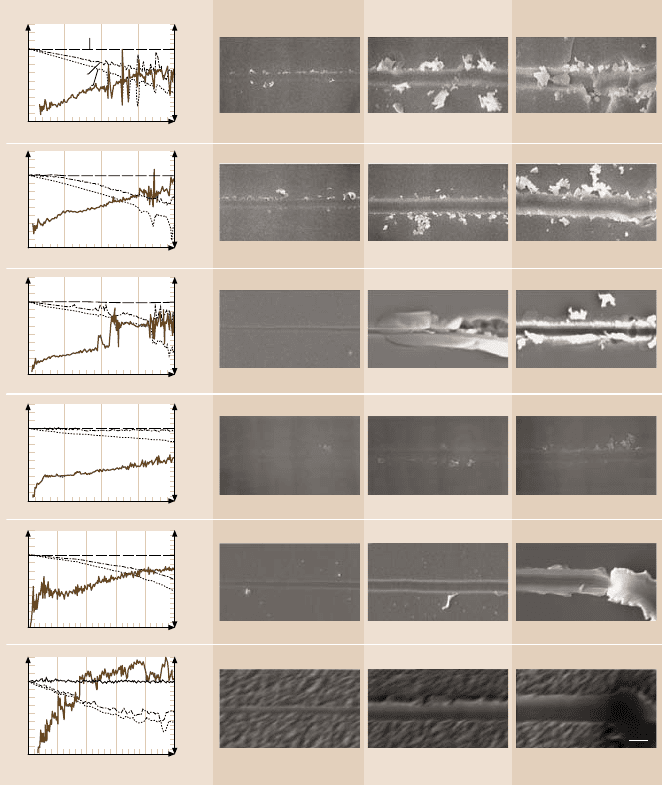
756 Bharat Bhushan
Coefficient of friction Scratch depth (nm)
Before scratch
During scratch
After scratch
Friction
1.2
0.8
0.4
0.0
50 101520
500
0
– 500
– 1000
– 1500
Undoped polysilicon film
B
A
C
1.2
0.8
0.4
0.0
50 101520
500
0
– 500
– 1000
– 1500
SiO
2
film
B
A
C
1.2
0.8
0.4
0.0
50 101520
500
0
– 500
– 1000
– 1500
SiC film
B
A
C
1.2
0.8
0.4
0.0
10234
1000
0
– 1000
– 1000
–3000
Ni-P film
B
A
C
1.2
0.8
0.4
0.0
1023
4
1000
0
– 1000
– 1000
–3000
Au film
B
A
C
1.2
0.8
0.4
0.0
50 101520
500
0
– 500
– 1000
– 1500
Undoped Si(100)
B
A
C
Region A Region B Region C
Normal load (mN)
2 μm
5
5
Fig. 14.9. Coefficient of friction and scratch depth profiles as a function of increasing nor-
mal load and optical images of three regions over scratches: at the beginning of the scratch
(indicated by A on the friction profile), at the point of initiation of damage at which the coef-
ficient of friction increases to a high value or increase abruptly (indicated by B on the friction
profile), and towards the end of the scratch (indicated by C on the friction profile) for all
samples [64]
bursts in the friction profile might result from the plastic deformation and material
pile-up in front of the scratch tip. The Au film exhibits a higher coefficient of fric-
tionthantheNi
−
P film. This is because the Au film has lower hardness and elastic
modulus values than the Ni
−
Pfilm.
